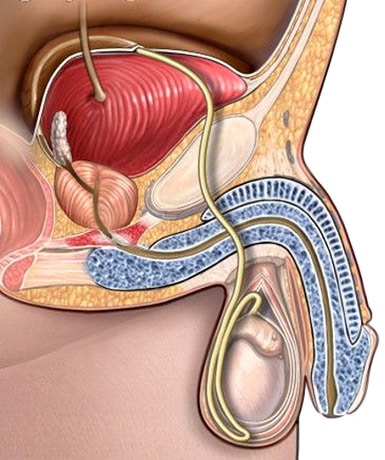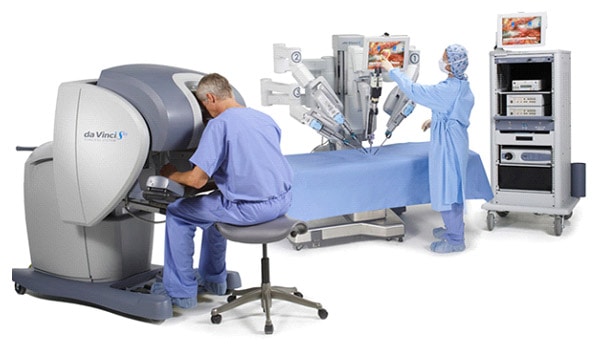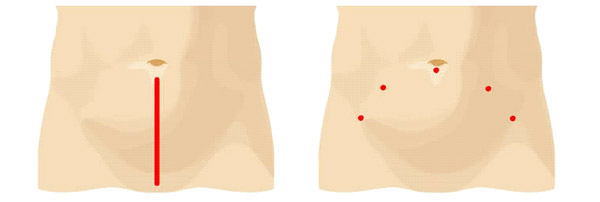Prostate Cancer – Robotic Surgery
To better understand your symptoms, visit us for a comprehensive diagnosis and personalised treatment plan
Prostate Cancer – Robotic Surgery
How common is early prostate cancer? Am I at risk of getting it?
The prostate is a walnut-sized gland that is part of the male reproductive system, and is found below the bladder in the male pelvis (Fig.1). Prostate cancer remains the most common cancer affecting men in the United States, Europe, and Australia. It is the third most common cancer affecting men in Singapore, and is usually diagnosed in men above fifty years of age.
Men with a positive family history of prostate cancer affecting their male relatives are at an increased risk of developing prostate cancer themselves1. Prostate cancer usually does not cause any symptoms in its early stages. It is detected by finding an abnormally raised serum prostate specific antigen (PSA) level, followed by an ultrasound-guided needle biopsy to confirm or exclude the presence of cancerous cells in the prostate.
With PSA blood tests becoming easily accessible over the last twenty years, the majority of men with prostate cancer are now diagnosed at an early curable stage of their disease.

Figure 1: The prostate gland is found below the urinary bladder deep in the male pelvis
Robotic Surgery and Robotic Prostatectomy
Robotic surgery refers to the use of a robotic surgical platform known as the da Vinci® Surgical System (Intuitive Surgical, Sunnyvale, USA) to perform minimally invasive surgery through small incisions. Since its inception in 2002, robotic prostatectomy has become hugely popular around the world. In Singapore and the United States today, 90% of all surgeries to remove cancerous are now performed using the da Vinci® robot.
This innovative technology comprises a surgical cart that is docked next to the operating table to small ports placed through incisions <1cm in the patient’s abdomen. Robotic wristed instruments are then passed through these small ports into the abdomen, which are controlled by the surgeon sitting at the operating console some distance away from the operating table.
A binocular camera lens affords the surgeon a 3-dimensional view of the operating field, which can be magnified up to 12 times. The surgeon then manipulates the camera lens and the various robotic instruments at the console using the hand controls and pedals.
These specially designed instruments afford the surgeon excellent precision and dexterity of surgical movement because of their patented robotic wrist technology.

Illustration
Figure 2: The da Vinci® Surgical System comprises a patient cart docked next to the patient on the operating table, while the surgeon operates from a console some distance away
Undergoing Robotic Surgery for Prostate Cancer
During robotic-assisted radical prostatectomy, the patient is put under general anaesthesia and surgical ports are placed through 6 keyhole incisions <1cm made in the abdominal wall, through which the robotic instruments are passed.
The bladder, prostate and seminal vesicles are dissected free from surrounding structures. The vasa deferentia (tubes carrying sperm from the testicles) are disconnected on both sides, and the prostate and seminal vesicles are removed after securing the blood vessels supplying these structures.
The bladder is then sewn to the urethra using sutures, and a urinary catheter left is left in the bladder for 5-7 days to allow adequate healing. In cases of low-risk prostate cancer, surgeons usually attempt to spare the nerves controlling erectile function and urinary control during the surgery, to facilitate earlier recovery of these vital functions.
Patients aged less than 65 years with no other significant health issues, are the group of patients who derive the most benefit from undergoing curative robotic surgery for prostate cancer.

Illustration
Figure 3: Illustration of conventional scar versus robotic keyhole scars for prostate cancer surgery
How long will I be in hospital after the surgery?
Most prostate cancer patients undergoing robotic surgery will experience significantly less bleeding and pain compared to conventional open surgery. In straightforward cases, patients usually return to the general ward on waking up.
With small surgical incisions, there is usually little pain after surgery, and patients are able to sit out of bed and walk the following day. Patients are usually discharged home after two or three days with an indwelling urinary catheter. This is removed around a week after surgery. They can expect to resume most normal activities of daily living and return to work 2-3 weeks after surgery.
What are the side effects of robotic prostatectomy?
Some degree of urinary leakage is usually experienced after the catheter is removed a week after surgery. Patients need to wear pads or diapers till their pelvic floor muscles become strong enough to resume adequate urinary control. With improved techniques of robotic surgery, most patients usually recover full urinary control within 3-4 months after surgery.
Erectile dysfunction is another commonly encountered side effect. However, this tends to take 9 months or longer to resolve, due to injury to the nerves during pelvic surgery.
My doctor told me that my prostate cancer is more aggressive than usual. Am I still a suitable candidate for robotic prostatectomy? Or should I consider conventional open surgery or radiation instead?
In recent years, many centres have reported positive outcomes with robotic surgery for aggressive prostate cancer, with surgical margin and PSA recurrence rates similar or better than open surgery.
In such high-risk patients, extended removal of the pelvic lymph nodes during time of surgery helps significantly reduce the likelihood of cancer recurrence. In patients whose cancer has spread outside of the prostate capsule or involved the attached seminal vesicles, a short course of adjuvant radiation may still be necessary to achieve complete eradication of viable cancer cells in the pelvis.
Summary
1. Prostate cancer is one of the most common cancers affecting men today
2. Surgery to remove cancerous prostates is widely performed nowadays using robotic surgical instruments through minimally invasive approach
3. Robotic surgery for prostate cancer delivers less pain, less blood loss, shorter hospital stay and earlier return of daily function when in experienced hands.
References:
1. Mottet N, Bastian PJ, Bellmunt J et al. EAU 2014 Guidelines on prostate cancer. European Association of Urology. http://www.uroweb.org/gls/pdf/09%20Prostate%20Cancer_LRLV2.pdf
2. Tan GY, Goel RK, Kaouk JH, Tewari AK. Technological advances in robotic-assisted laparoscopic surgery. Urologic Clinics of North America 2009; 36: 237-49.
3. Tan GY, El Douaihy Y, Te AE, Tewari AK. Scientific and technical advances in continence recovery following radical prostatectomy. Expert Review of Medical Devices 2009; 6: 431-53
4. Bill-Axelson A, Holmberg L, Garmo H et al. Radical prostatectomy or watchful waiting in early prostate cancer. New England Journal of Medicine 2014; 370: 932-942
5. Xylinas et al. Is radical prostatectomy a viable therapeutic option in clinically locally advanced cT3 prostate cancer? British Journal of Urology International 2010; 106: 1596-1600
Request an Appointment
In the past decade, medical expulsive therapy (MET) for ureteral stones has become increasingly popular. Various medications, such as calcium channel blockers, α-blockers, and corticosteroids have been investigated. Failure of stones to pass out after 4 to 6 weeks of medical treatment will necessitate intervention to remove these stones1-3.
